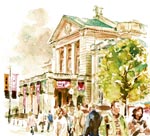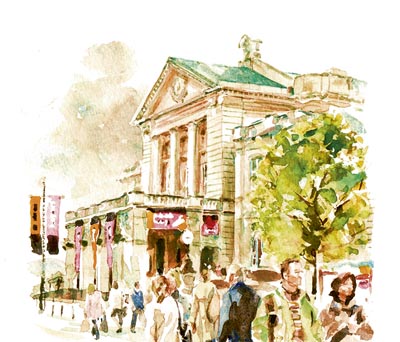Property profile: Cheltenham
Cheltenham has been a popular market town for 300 years, and it’s lost none of its appeal in this time


When to be in town
For four days in March, Cheltenham becomes Britain's sporting hub as people converge here for the National Hunt Racing Festival, with the coveted Gold Cup top of the bill. ‘The whole place comes alive,' said Julian Archard of Savills. ‘It's hugely social: a highlight of the calendar.'
And that calendar is full. The Jazz Festival grooves through May, with thousands cramming into Montpellier Gardens. The Science Festival hogs the spotlight in June, questioning, explaining and experimenting in the Town Hall and Imperial Gardens. Come July, the Music Festival takes over, reminding everyone that Cheltenham is the birthplace of composer Gustav Holst. Finally, in October, bookworms get their moment with the Literature Festival, which draws more than 600 authors and poets.
And where to go out of town
South of Cheltenham, Leckhampton Hill and its Devil's Chimney are a fun daytrip: legend has it that a penny placed on the limestone chimney will placate Old Nick below. The more energetic can cross Cleeve Hill to the north, rewarded by Winchcombe and the historic gardens of Sudeley Castle on the other side.
For everything you need...
The quiet streets around Tivoli bring a little Italian flavour to Cheltenham's otherwise French- influenced food culture. The Long Garden on the Promenade is another source of fresh ingredients, with its fortnightly farmer's market, as well as an occasional French market.
Sign up for the Country Life Newsletter
Exquisite houses, the beauty of Nature, and how to get the most from your life, straight to your inbox.
...and anything you don't
The Promenade in Cheltenham has been described as the ‘Bond Street of the West', with beautiful façades that date back to the mid 1800s. Nearby Regent Arcade is perhaps best known for its three-ton Wishing Fish Clock, which gurgles out bubbles to mark each half hour. Montpellier Walk, lined by 32 caryatids, is home to boutiques such as Cousins, for tweeds and country fashion (at No 10), and the lavish silks of Beatrice Von Tresckow (at No 8).
From morning coffee to dining out
The Montpellier district has courted the stylish set since the first half of the 19th century. Today, its ornate buildings are home to many of the town's best bars and restaurants, led by the two-Michelin-starred Le Cham-pignon Sauvage (24-28, Suffolk Road). Also Continental in style, the Montpellier (1-3, Montpellier Terrace) is a bustling brasserie, backed by an art gallery.
The Montpellier Chapter (Bayshill Road) takes refreshment very seriously, whether you're thirsting for afternoon tea or a Champagne cocktail, and affords views of villas and ornamental gardens from the bar terrace. The aptly named Hotel du Vin, in Parabola Road, has 14 sommeliers, just in case. Lately, however, a small breakaway, known as The Suf-folks, has rocked the Montpellier monopoly. The chic establishments around Suffolk Square are drawing those in the know, in particular the Suffolk Kitchen (8, Suffolk Parade).
Out and about
Local theatregoers can often steal a march on Londoners, as the beautifully restored Every-man (7-10, Regent St), with its domed ceiling, will trial productions before their launch on the West End.

* Subscribe to Country Life and save; Get the Ipad edition
How to keep fit
For the past 140 years, Gloucestershire County Cricket Club has hosted the world's longest-running cricket festival, the Brewin Dolphin, against the background of Cheltenham College. Tennis, squash and hockey are at the East Glos Club in Old Bath Road and croquet is at the Cheltenham Croquet Club, also in Old Bath Road, which has 11 full-size lawns.
The nearby Lilley Brook golf course, in Cirencester Road, was designed by Dr Alister MacKenzie, architect of the Augusta National in Georgia, home of last month's US Masters.
Locally, steep slopes and woodland provide first-rate game shoots, and the Cotswold Hunt country is easily accessible-the popular Boxing Day meet at the Frogmill Inn in Andoversford shouldn't be missed.
Cool for school
Ask any agent what drives property in Cheltenham, and the first answer is invariably ‘education'. The town has excellent State, grammar, prep and public schools -in particular, Cheltenham College, Cheltenham Ladies' College, Dean Close and Pate's Grammar School. ‘Parents who move here for the duration of their child's education account for much of the market turnover,' explains Rob Fanshawe of Property Vision.
An additional draw, says Mr Archard, is that ‘the gap in house prices between London and Cheltenham has never been larger. We meet a lot of parents who want to exchange their place in, say, Fulham or Chiswick for a Regency town house, with a bit left over for school fees.'
Where to buy property in town...
Cheltenham is described as Britain's most complete Regency town. Among the many fine examples are the Pittville Pump Room and the terraced Lans-down Crescent. The Pittville area and The Park-an unusual, pear-shaped road-are the best places to buy elegant period town houses. However, Cheltenham's social buzz has increased the popularity (and price) of central apartments, with Montpellier topping the charts of the most sought-after location. ‘We've certainly seen a trend of downsizing,' says Miss Simmonds. ‘Our clients want to be part of the town's cafe culture.'
...and out of town
Villages to the east of the town, especially those in the triangle formed by the A40, Northleach and North Cerney, are highly sought-after, with a typical price tag of between £1 million and £3 million. ‘Those top-notch villages are perfect for parents who want a mix of the town and country,' says Charlie Wells of Prime Pur-chase. ‘The school commute is easy, helped by a manageable network of back lanes if all the A-roads are snarled up.'
However, Peter Edwards of Knight Frank warns: ‘The area has become a victim of its own success: there are few properties on the market at any one time and they are very quickly snapped up'.
*Follow Country Life magazine on Twitter
Country Life is unlike any other magazine: the only glossy weekly on the newsstand and the only magazine that has been guest-edited by HRH The King not once, but twice. It is a celebration of modern rural life and all its diverse joys and pleasures — that was first published in Queen Victoria's Diamond Jubilee year. Our eclectic mixture of witty and informative content — from the most up-to-date property news and commentary and a coveted glimpse inside some of the UK's best houses and gardens, to gardening, the arts and interior design, written by experts in their field — still cannot be found in print or online, anywhere else.
-
 380 acres and 90 bedrooms on the £25m private island being sold by one of Britain's top music producers
380 acres and 90 bedrooms on the £25m private island being sold by one of Britain's top music producersStormzy, Rihanna and the Rolling Stones are just a part of the story at Osea Island, a dot on the map in the seas off Essex.
By Lotte Brundle Published
-
 'A delicious chance to step back in time and bask in the best of Britain': An insider's guide to The Season
'A delicious chance to step back in time and bask in the best of Britain': An insider's guide to The SeasonHere's how to navigate this summer's top events in style, from those who know best.
By Madeleine Silver Published
